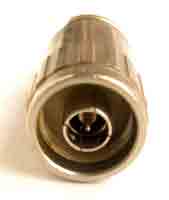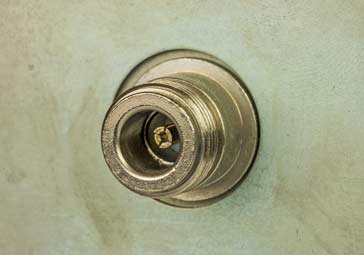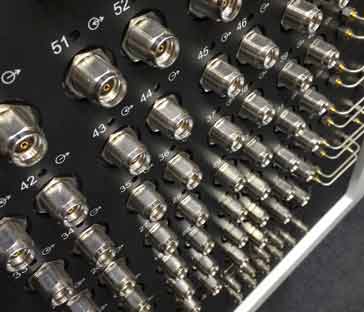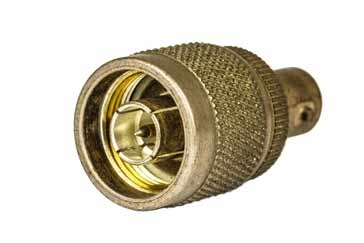N-type Connector
The N-type connector is an RF connector used where high powers, high frequencies (up to 11 GHz and more) are required along with high performance.
RF Coax Connectors Includes:
RF connectors
RF connector specifications
BNC connector
TNC connector
N-type connector
SMA connector
SMB connector
MCX connector
Precision connectors
UHF connector
F-type
Related connector types:
Other connectors
The N-type connector is a high performance RF coaxial connector. The N-type RF connector is used in many applications, particularly where RF performance is of paramount importance.
Although not used as widely in small laboratories and hobbyist applications, the N-type connector is particularly good where high powers and high performance are needed. Being physically larger than other types of connector such as the BNC connector, the N-type connector is more suited to use with the larger low loss cables.

... the N-type connector is used in many applications where RF performance is of paramount importance....
N-type development
The N-type connector has been in use for many years. It was originally designed by Paul Neill of Bell Laboratories, and it is said to have gained its name from the first letter of his surname, although some references state that the N stands for Navy where the connector was initially used.
The development of the N-type connector arose out of the need for a high performance RF connector with a constant impedance, and its initial design aim was to perform up to 1 GHz. Since its first introduction, it has found many applications in areas where good RF performance is needed, along with the ability to carry high levels of power, and to be used with the larger sized coaxial cables. Also its peformance has been shown to extend well beyond the initial 1 GHz design aim.
N-type performance
The connector has a threaded coupling interface to ensure that it mates correctly to provide the optimum performance.
There are two versions of the N-type connector that are available:
- 50 ohm
- 75 ohm

Of the two versions of this RF connector that are available, it is the 50 ohm N-type connector that is by far the most widely used. This results from the fact that 75 ohm systems are only rarely used in commercial and professional systems these days.
The two versions of the N-type connector have subtle mechanical differences that do not allow the two types to mate. If connectors of the two different types are connected together, then this can lead to damage. The 50Ω connector system has a larger centre pin to provide the lower characteristic impedance, and this can lead to irreversible damage if it is mated with a 75Ω connector. Some manufacturers provide enough spring for the connectors to accommodate this, whereas others do not, so it is best to keep the two standards apart.
The connector able to withstand relatively high powers when compared to the BNC or TNC connectors. The standard versions are specified for operation up to 11 GHz, although precision versions are available for operation to 18GHz.
The N-type coaxial connector is used for many radio frequency applications including broadcast and communications equipment where its power handling capability enables it to be used for medium power transmitters, however it is also used for many receivers and general RF applications.
The suggested tightening toque on the body outer shell varies between different manufacturers, Often good hand tight is what is normally used, but for a more exact figure, the manufacturers data sheet should be consulted. Typically it is around 15 inch-pounds or 1.7 N m. As the torque limit depends only on thread quality and cleanliness, the main operational requirement is good RF contact without significant steps or gaps. Accordingly it is possible to have a reasonably margin on the figures stated.

N-type power rating
The N-type connector is known for its performance and also its power handling capability. Other connectors may be able to provide high frequency performance, but when it comes to needing a connector that is able to handle a reasonable level of power, the N-type is one of the popular options.
The peak power capability of an N connector is determined by voltage breakdown within the region of the centre pin. However the average power rating is determined by the level of heating that occurs on the centre contact due to the resistance , particular at the contact points. This is frequency dependent as a result of the skin effect.
The actual power handling capability of any given connector will be given in the manufacturer’s data sheet for that particular connector - it will vary somewhat from manufacturer to manufacturer as a result of the different materials used fort he contacts and finishes.
As a guide a new and clean connector with a perfect load (VSWR = 1:1.0) might be expected to handle 5000 watts at 20 MHz, but this could fall to 500 watts at 2 GHz.
When using parts from unknown manufacturers, it is advised that a significant safety margin is included as some product on the market will be of significantly inferior quality.
| N-Type RF Connector Specification Summary |
|
|---|---|
| Parameter | Specification |
| Cable Type | Coaxial |
| Impedance | 50Ω & 75Ω (note the ratio of the diameters of the conductors differ between types and therfore they cannot mate together). |
| Frequency range | Typically 11 GHz, although some precision versions are specified to 18 GHz. |
| Typical outer diameter (male) | 0.800 inches / 20.3 mm |
| Typical outer diameter (female) | 0.620 incheas / 15.7 mm |
| Connector thread | 5/8inch 24 turns per inch UNEF thread |
Connector formats
N-type connectors come in a variety of formats. Not only are there plugs and sockets but there are also adapters and also other items such as attenuators.
N-type plugs are designed not only for the required impedance, but also to accept a particular coax cable format. In this way all the internal piece parts are compatible with the coaxial cable used. It is therefore necessary to specify the N-type plug for use the cable to be used. Although there is some latitude, it is naturally best to select the correct cable format.

N-type connectors are often used where performance is of paramount importance, and under these circumstances large cables are often needed to ensure the levels of loss are minimised. In view of the fact that N-type connectors are slightly larger than either BNC or TNC connectors this makes them ideal for these applications. Accordingly a variety of N-type connector versions capable of accommodating larger types of coax cable are available.
In addition to this there are straight and right angled variants. Of these the straight connectors are the most widely used, although right angled connectors where the cable leaves the plug at right angles to the centre of the connector centre line are also available. These are ideal in many applications where the cables need to leave the connector in this manner to ensure cables are in a tidy fashion, or where space is at a premium. Unfortunately right-angled connectors have a marginally higher level of loss than their straight through counterparts. This may not be significant for most applications, but at frequencies near the operational limit of the connector there may be a small difference.
The sockets or female N-type connectors also come in a number of flavours. In view of the fact that TNC connectors are normally used for RF applications, bulkhead mounting connectors where coaxial cable entry is provided are normally used. Again these are available for a variety of cable dimensions and the correct type should be used.
More Electronic Components:
Batteries
Capacitors
Connectors
Diodes
FET
Inductors
Memory types
Phototransistor
Quartz crystals
Relays
Resistors
RF connectors
Switches
Surface mount technology
Thyristor
Transformers
Transistor
Unijunction
Valves / Tubes
Return to Components menu . . .



